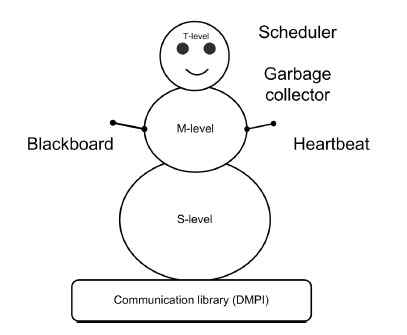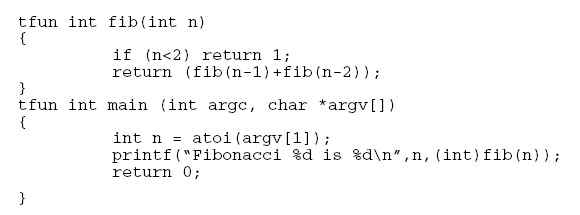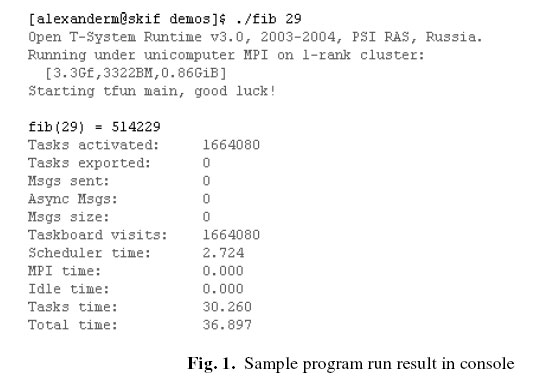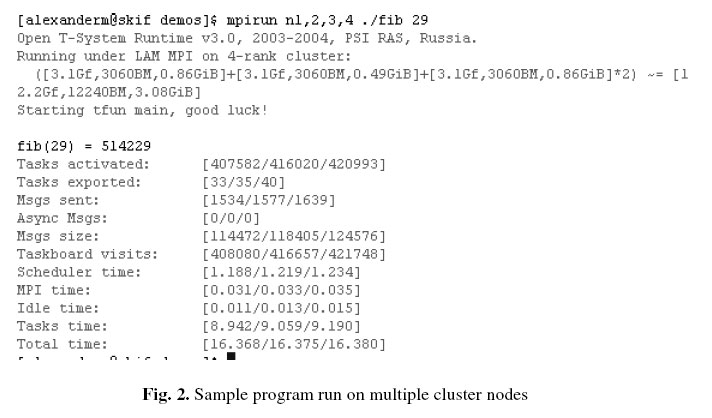Open TS: An Outline of Dynamic Parallelization Approach
Sergey Abramov1, Alexei
Adamovich1, Alexander Inyukhin2, Alexander
Moskovsky1,
Vladimir Roganov1, Elena
Shevchuk1, Yuri Shevchuk1, and Alexander
Vodomerov2
1 Program System Institute, Russian Academy of
Sciences, Pereslavl-Zalessky, 152020, Russia, Yaroslavl Region. +7
08535 98 064 (phone&fax) abram@botik.ru
2 Moscow, 119192,
Michurinsky prosp., 1, Institute of Mechanics of MSU,
Russia
Abstract. The paper is dedicated to an open
T-system (OpenTS) - a programming system that supports automatic
parallelization of computations for high-performance and distributed
applications. In this paper, we describe the system architecture and
input programming language as well as system's distinctive features.
The paper focuses on the achievements of the last two years of
development, including support of distributed, meta-cluster
computations.
1 Open T-System Outline
Open T-System (Open TS) is a recent dynamic program
parallelization technology for high-performance and distributed
applications. It originates from functional and metaprogramming
technologies [1, 2] and tries to achieve maximum performance of
single/multi-processors, supercomputers, clusters and meta-clusters.
Another goal was the development of easy-to-use tools for parallel
programming, with high learning curve and easy legacy code support.
With initial implementations of T-system dated back to nineties and
end of eighties of the last century, Open TS is a third generation
of the T-system [3]. The Open TS approach allows addressing in a
uniform way parallel computing problem for mutli-core processors,
SMP systems, computational clusters and distributed systems. As
well, Open TS facilitates parallel applications with non-uniform
parallelism grains or parallelism grains defined at runtime.
1.1 Related Work
The Open TS design utilizes many concepts of parallel computing.
First of all, it devises high-level parallelizing approach, while
many of them currently exist [4]. Secondly it utilizes an extension
of C++ language to express parallelism, while many other extensions
of C and C++ for parallel computing were developed [5]. Thirdly, the
concept of T-system is based upon functional programming approach
[1], that make it very similar to parallel implementations of
functional languages [6]. At last, Open TS runtime implementation
utilizes Distributed Shared Memory (DSM) [7], mutli-tier
architecture [8] and C++ template- based design [9]. Here we note
separately only small fraction of all works in this field, not
comprehensive but representative, as we hope:
- Charm++ [10] is a C++ extension for parallel computing, which
is used to create high-performance codes for supercomputers [11].
Open TS is different in many aspects - from runtime implementation
to language semantics. The most important is that Open TS uses
functional approach for parallelization, while Charm++ uses
asynchronous communication with object-oriented model.
- mpC++ is another example of successful implementation of
"parallel C" for computational clusters and heterogeneous clusters
[12]. While mpC uses explicit language constructions to express
parallelism, Open TS has implicit parallelization constructs.
- Cilk is a language for multithreaded parallel programming
based on ANSI C [13]. Cilk is designed for shared memory computers
only, in contrary Open TS can be run on computational clusters and
meta-clusters.
- Glasgow Parallel Haskell is a well-known extension of Haskell
programming language [14]. Open TS is similar with GPH by
utilizing some implicit approach to parallelizing computation,
while enabling low-level optimization on C++ level, unavailable in
Haskell.
- OMPC++[15] is very similar to Open TS in many aspects,
especially in the way of using C++ templates in runtime. However,
language extensions are of primary importance for Open TS concept.
While many parallel programming techniques, like Unified Parallel
C [16] and CxC [17] are not covered in our comparison, Open TS
distinctions will be virtually the same.
1.2 Programming Model
Unlike many tools for parallel programming, T-System does not try
to change the usual programming model too much. Native input
language is a transparent attributebased extension of C++; however,
other T-dialects of programming languages are in the development
stage: T-FORTRAN, T-REFAL. Only two new notions are really important
for programming: T-function and T-value. T-values are extensions of
basic C values with non-ready value, read access to a non-ready
value stops execution of a T-function, unless C-value is provided
during computation. T-functions are pure Cfunctions forming
functional model at the top level of program structure. However,
imperative C exists inside T-functions enabling potential for
low-level optimization. Support for object oriented-model is
forthcoming.
An important feature of Open TS is a separation of the
computation code from the scheduling code. In Open TS, the
programmer is enabled to develop complex strategies for dynamic
parallelization without affecting the computational code itself.
1.3 Execution Model
Parallel execution is based on a completely conflict-free
data-flow model, and the "macro-scheduling" algorithm distributes
computational tasks (active T-functions) over all available
computing resources on the fly. Thus, latency hiding should enable
very high computational power utilization. Moreover, heterogeneous
(e.g. different CPU speeds) computational clusters can be
efficiently loaded with that approach.
Special hardware such as application-specific accelerators and
processors can be also considered as specific computational
resources, it is dynamically loaded in the same way.
|
(1) Opens supports the usage of more
than one million of threads even in one usual processor -
this was shown practically, this was used in real
applications. |
Millions of threads1 can work in a cooperative and
conflict-free way enabling latency hiding: any time non-ready
T-value is reached, T-System switches rapidly to another
ready-to-compute task. In this way, T-System avoids blocking
computation in many cases when communication infrastructure permits.
In brief, T-System may be a good candidate to fill up the gap
between fast recent CPUs and latency-restricted communications.
1.4 T-Applications
T-application is a self-contained, dynamically linked executable.
In a nutshell, it recognizes the execution environment and
automatically loads a corresponding communication driver on the fly.
The execution environment may be one of the following.
- Unicomputer - runs as a single process
- SMP - runs on a machine with symmetric multi processing
capabilities
- MPI (6 flavors are supported now, including PACX MPI and
MPICH-G2 for the meta-cluster environment)
- PVM.
Thus, T-applications don't need to be recompiled or re-linked for
all possible communication flavors. This is important in many cases,
especially in meta-clusters with heterogeneous MPI
implementations.
2 Open T-System Design Notes
Open T-System runtime has a microkernel-based design.
Microkernel, or TSuperstructure, is a central part of the runtime.
It contains all essential entities that a typical program needs to
be run on. T-Superstructure has a "snowman" architecture of three
tiers: `S' ("super-memory" and "super-threads"), `M' (mobile objects
and references) and `T' (T-values, variables, references,
functions). Being compact in size (less than 5 000 lines in about
100 C++ classes), it suits for various extensions: enhanced task
schedulers, memory allocation schemes, custom thread systems, and so
on. A special class 'Feature' is used to register extension
plug-ins, which are typically dynamically linked at the startup
stage. The microkernel can be easily ported to `almost pure'
hardware, because it is almost self-contained. C++ [cross] compiler
only is required for such porting. However, since C++ templates are
used extensively, a modern C++ compiler is required.
Fast context switch is a special feature of Open TS, which is
very important for efficient T-applications. Since T-applications
are known to create millions of simultaneous threads, fast switching
is key important. Today, the T-context switch is 10 times faster
than the fastest standard thread library switch.

A "Supermemory", or special kind of distributed shared memory, is
located outside of program data and used to manage T-values. Novel
communication technologies such as hyper-transport can be directly
incorporated into the "Supermemory" layer to avoid an unnecessary
MPI overhead. Super memory is utilized in six different ways:
- T-Values
- Task exchange
- Resource information exchange
- Memorization table
- "Heartbeat" (see below)
- Shutdown signal
The fault-tolerance support has been implemented with the help of
LAM MPI BLCR checkpoint system [18]. It is integrated with the
T-System runtime, thus making fault-tolerant computing easier.
Since the T-system originates from the functional programming
model, it is possible to implement the fault-tolerance on the base
of re-computing of T-functions. This work is forthcoming.
3 Compilation of T-Programs
Two approaches are followed to develop compilers for T++
programs.
The first, "converter", approach utilizes OpenC++ [19] parser to
translate a T++ program to a C++ program using Open TS runtime
library calls. Advantage of that approach is that the best-of-breed
C++ compiler can be used, with the best processorspecific
optimization available. The drawback is some C++ syntax features
that are not supported seamlessly due to Open C++ limitations.
An alternate, "compiler", approach is based on an open-source GNU
C++ compiler. An extra front-end language for T++ has been
implemented, it has a smooth and comprehensive support of all C++
language features. However, if the GNU C compiler optimization is
not on a par with the other compilers of the target platform, a
performance loss might happen.
4 T-Application Development Stages
First of all, T++ is a transparent attribute-based dialect of
C++. The T++ code can be trivially mapped to the sequential C++
program by masking T-attributes on the preprocessor stage. To start,
the T++ code may be developed and debugged without T-System.
Then, the `t++' compiler may be used to obtain T-executables
which should be able to normally run on the unicomputer. Thus, the
second stage of the development process is to check whether
everything works correctly on the unicomputer - this involves
usual testing and debugging for the traditional (one-processor)
case.
Furthermore, the same executable may be run on the `cluster
emulation'. The simplest way to do this is to use LAM on various
Linux systems: the command
mpirun n0,0,0,0 <t-executable>
will emulate the 4-node cluster. Some tuning can be done at this
stage. Finally, run T-executable on the desired target platform.
5 T-Application Debugging and Tuning
T-System has a number of built-in profiling, tracing and
debugging facilities.
First of all, debugging is facilitated by several modes of
compilation: "optimized", "normal" and "debug". The "optimized" mode
uses the runtime version with heavy optimization. The runtime of the
"normal" mode is simplified as compared to the "optimized" version.
If an application is compiled in the "normal" mode and a problem
persists, it should be attributed to the application itself -
not the runtime - with high degree of confidence. Moreover, the
"debug" mode generates a large amount of debug output, which helps
programmers to understand the current situation in T-runtime and
applications. This output can be filtered with the help of regular
expressions.
A full-fledged Trace facility has also been implemented for
T-applications. When the program is finished, some statistical data
is printed (see figures below). It includes minimal/medium/maximal
(depending on computational nodes) values of the following
parameters: used CPU time, communication time, idle time. This hot
profiling information may be very useful for the tuning of
applications. Communication message logs can be called in order to
understand which communication traffic occurred during the program
execution. A T-function call graph can also be obtained.
If the program crashes, some information (including program call
stack with source line numbers) is printed. Optionally, the debugger
is started at the same time, which may be very convenient for a
rapid problem discovery.
Finally, a special heartbeat logic is used to discover broken
program/communication state. If heartbeat timeout is reached without
any data exchange, then all T-processes will exit automatically.
6 Sample Program Run
The example program is the calculation the Fibonacci number.
Since it is not very hard computationally, it is a good test for the
runtime system, and it illustrates well the simplicity of T++
programming.

The only T-function is the "fib" function which recursively calls
itself. Since the result of "fib" is a non-ready value, explicit
casting to int is necessary for the program to run correctly. The
casting results in the "main" thread wait until the result of "fib"
is ready. "fib" recursively calls itself creating a tree, while the
tree branches can be computed in parallel.
Compiling the program is possible with either t++ or tg++.
t+ -o fib0 fib0.tcc
The process of the program execution is illustrated in Fig. 1
(running on single processor) and Fig. 2 (running on four-cluster
nodes). You may see some speedup demonstrated by "fib". The example
has been a mere illustration that doesn't reflect the real quality
of T-system, benchmarking results will be published elsewhere.


7 T++ Language in a Nutshell
The T++ language is a semantically and syntactically "seamless"
extension of C++. The language constructions are enumerated below
with short descriptions following them:
tfun - a function attribute which should be
placed just before the function declaration. Now, the function
cannot represent a class method but must be an ordinary C function.
A function with the "tfun" attribute is named
"T-function".
tval - a variable type attribute
which enables variables to contain a non-ready value. The variable
can be cast to the "original" C++-type variable, which makes the
thread of execution suspend until the value becomes
ready.
tptr - a T++ analogue of C++ pointers
which can hold references to a non-ready
value.
tout - a function parameter attribute
used to specify parameters whose values are produced by the
function. This is a T++ analog of the "by-reference" parameter
passing in C++.
tct - an explicit T-context
specification. This keyword is used for specification of additional
attributes of T-entities.
tdrop - a T++
-specific macro which makes a variable value ready. It may be very
helpful in optimization when it's necessary to make non-ready values
ready before the producer function finishes.
8 Runtime Performance
The detailed performance study of Open TS runtime is out of the
current paper scope and will be published elsewhere. However,
overall runtime performance and quality is good enough to stimulate
many groups outside of Program Systems Institute to develop their
own applications with Open TS (see below). Best speedup achieved
with image-processing application is approximately 60% of linear
speedup on 32-processor computational cluster with Scalable Coherent
Interface (SCI) interconnect.
9 Applications
Approximately a dozen of applications have been developed with
the help of Tsystem. Some of them are the following:
- Plasma physics modeling tool
- Aerodynamics simulation package
- Tools for computational modeling in chemistry
- Automatic text categorization package
- Radar image modeling application
- Remote sensing images processing
10 Support
Open T-System is being developed in the Program System Institute
of the Russian Academy of Sciences (PSI RAS) as a key technology in
the SKIF Super-Computing project. The system support can be obtained
via e-mail: opents@botik.ru
(developers' conference).
11 Work in Progress
We are also working on various application-oriented T-libraries.
Such libraries are represented as the T++ code (working also in pure
C++) and may be used without any knowledge of T++ or even parallel
programming at all. Using the C++ inheritance mechanism, an
application programmer just needs to define several
applicationspecific methods - virtual functions - to
obtain a complete highly-parallel computational component for a
custom high-performance application. Other development areas if
macro-scheduling schemas for meta-clusters and other distributed
systems.
12 Acknowledgements
This work is supported by joint "SKIF" supercomputing project of
Russia and Belarus and basic research grant from Russian Academy of
Science program "Highperformance computing systems on new principles
of computational process organization" and basic research program of
Presidium of Russian Academy of Science "Development of basics for
implementation of distributed scientific informational-computational
environment on GRID technologies".
References
- Field A.J, Harrison P.: Functional Programming (International
Computer Science Series), Addison-Wesley (1988)
- (a) Turchin V.F.: The concept of a supercompiler Transactions
on Programming Languages and Systems.--v .8, N 3 (1986) .292 -325.
(b) Ershov A.P., D.,Futamura Yo.,Furukawa K.,Haraldsson
A.,Scherlis W.L.:Selected Papers from the Workshop on Partial
Evaluation and Mixed Computation. New Generation Computing. v.6 ,
N 2 -3.
- (a) Abramov S. M., Adamovich A. I., Kovalenko M. R.: T-system
as a programming environment with automatic dynamic support
parallelization support. An example with implementation of
ray-tracing algorithm Programmirovanie, No 25 (2), 100-107.(in
Russian) (b) Abramov S. M., Vasenin V. A. , Mamchits E. E.,
Roganov V. A.: Slepukhin A.F. Dynamic parallelization of programs
based on parallel graph reduction. A software architecture of new
T-system version. Proceedings book of MIPHI scientific session,
22-
26 January 2001, v. 2, Moscow, 2001. (in Russian)
- High-level Parallel Programming and Applications Workshop 2003
Proceedings in Parallel Processing Letters , .v. 13, issue 3.
- Gregory V.: Wilson (Editor), Paul Lu (Ed.) Parallel
Programming Using C++ MIT Press, 1996
- H-W. Loidl , F. Rubio , N. Scaife, K. Hammond , S. Horiguchi ,
U.Klusik , R. Loogen , G.J. Michaelson , R. Pena , S. Priebe ,A.J.
Rebon and P.W. Trinder: Comparing parallel functional languages,:
programming and performance. J. of Higher-order and Symbolic
Computation, 2003
- J.B. Carter, D. Khandekar, L. Kamb: Distributed shared memory:
where we are and where we should be headed. Fifth Workshop on Hot
Topics in Operating Systems (HotOS-V) May 04 - 05, 1995 Orcas
Island, Washington
- M. J. Vianna. E. Silva, S. Carvalho, J. Kapson,: In
Proceedings of the 2nd European Conference on Pattern Languages of
Programming (EuroPLoP '97). Siemens Technical Report 120/SW1/FB.
Munich, Germany: 1997
- Andrei Alexandrescu.: "Modern C++ Design: Generic Programming
and Design Patterns Applied" , Addison Wesley Professional., ISBN:
0201704315;2001
- L. V. Kaleev, Sanjeev, Krishnan :Charm++: Parallel Programming
with Message-Driven Objects. In [5] 175-213
- James C. Phillips Gengbin Zhengy Sameer Kumary Laxmikant V.
Kaley :NAMD: Biomolecular Simulation on Thousands of Processors.
In: Supercomputing 2002
conference proceedings http://sc-2002.org/paperpdfs/pap.pap277.pdf
- Alexey Lastovetsky: mpC - a Multi-Paradigm Programming
Language for Massively Parallel Computers, ACM SIGPLAN Notices,
31(2):13-20, February 1996
- Cilk: Efficient Multithreaded Computing by Keith H. Randall.
Ph. D. Thesis, MIT Department of Electrical Engineering and
Computer Science. June 1998. http://supertech.lcs.mit.edu/cilk/
- Pointon R.F. Trinder P.W. Loidl H-W.: The Design and
Implementation of Glasgow distributed Haskell: IFL'00 - 12th
International Workshop on the Implementation of Functional
Languages, Aachen, Germany (September 2000) Springer Verlag LNCS
2011, pp 53-70 15. Yukihiko Sohda, Hirotaka Ogawa, Satoshi
Matsuoka OMPC++ - A Portable High- Performance Implementation of
DSM using OpenC++ Reflection. Lecture Notes In Computer Science;
Vol. 1616 pp 215-234 Proceedings of the Second International
Conference on Meta-Level Architectures and Reflection , 1999,
© "СКИФ"
2002
|




